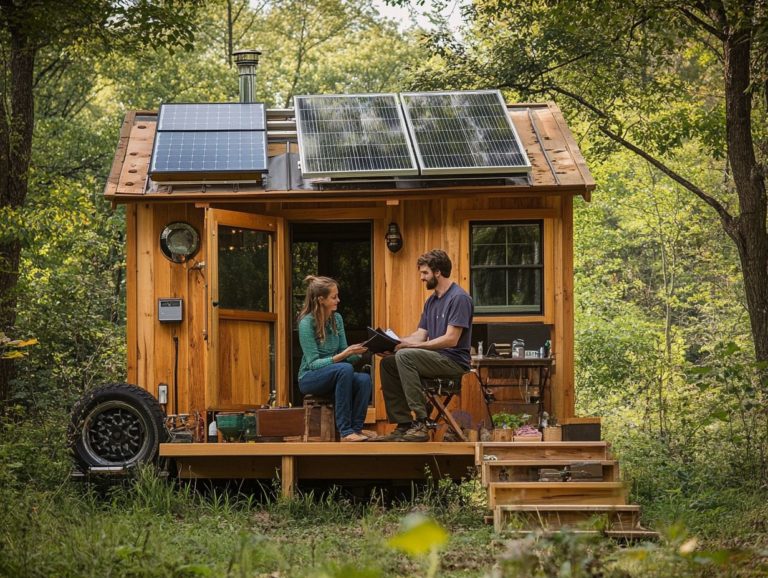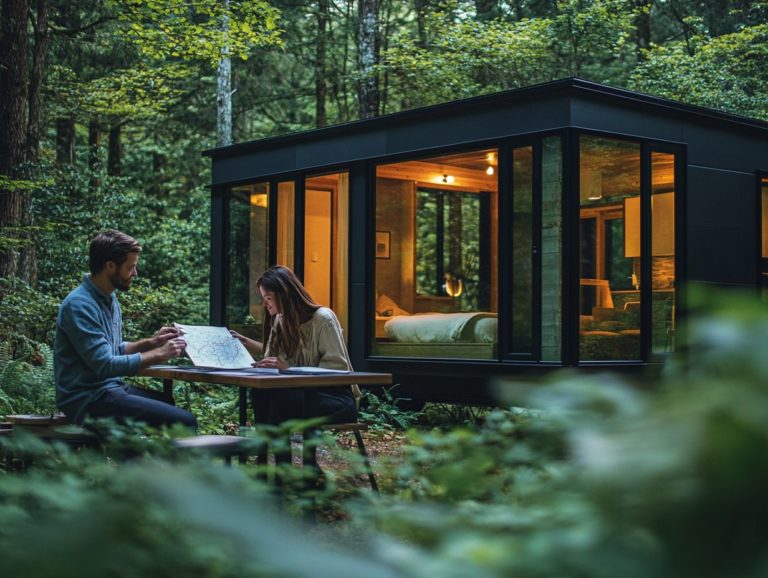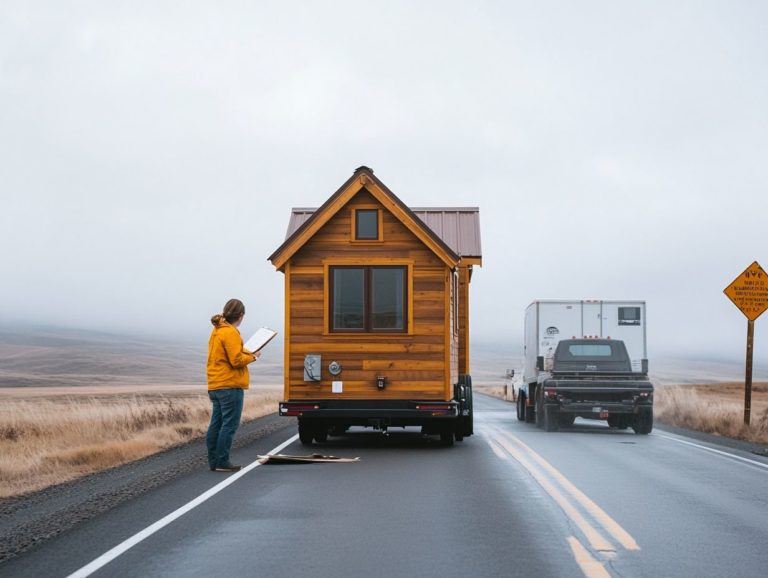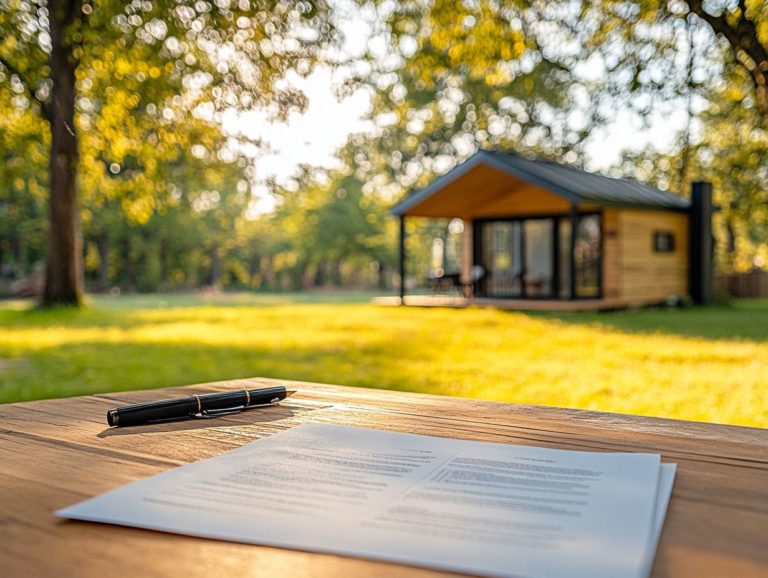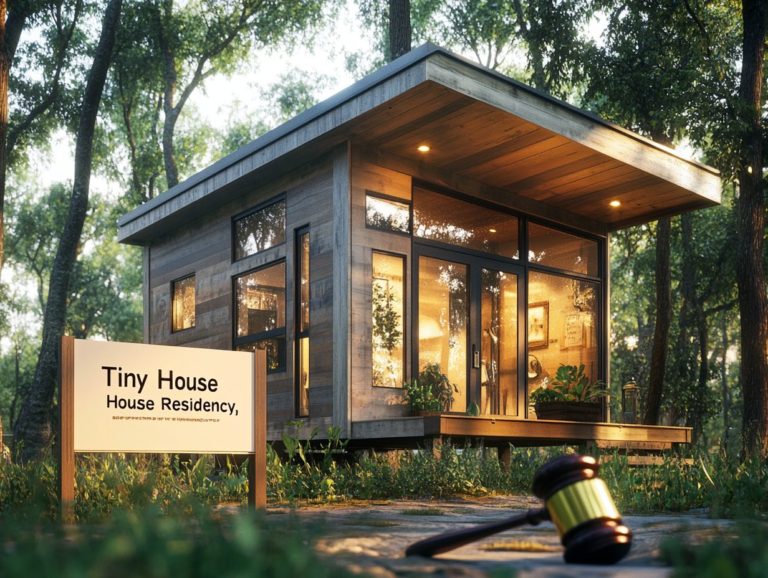Legal Considerations for Tiny House Renovations
Tiny houses are quickly becoming the hot new lifestyle choice! They blend minimalism and sustainability into a compact, appealing package that reflects the principles of the Tiny House Movement.
Renovating these distinctive dwellings, including accessory dwelling units, brings its own set of challenges and considerations. You’ll need to grapple with zoning laws and building codes, especially tiny house regulations. Additionally, exploring financing and insurance options is crucial there s quite a bit to consider.
This guide will equip you with the essential legalities, including tiny house laws, financing strategies, material choices, and design tips. With this knowledge, you can create a functional and stylish tiny space that perfectly aligns with your needs.
Delve into this resource to uncover the secrets to a successful tiny house renovation. Discover the benefits of choosing a tiny house on wheels or a tiny house on a foundation.
Contents [hide]
- Key Takeaways:
- What are Tiny Houses and Why Renovate?
- Legal Considerations for Renovating a Tiny House
- Financing and Insurance for Tiny House Renovations
- Insurance Coverage for Renovations
- Choosing Materials and Contractors
- Sustainable and Safe Materials
- Finding Reliable Contractors
- Maximizing Space and Functionality
- Frequently Asked Questions
- What are the legal considerations for tiny house renovations?
- Do I need a permit to renovate my tiny house?
- Are there any zoning restrictions for tiny house renovations?
- What safety standards should I consider for my tiny house renovations?
- Can I legally rent out my renovated tiny house?
- What legal documents should I have for my tiny house renovations?
Key Takeaways:
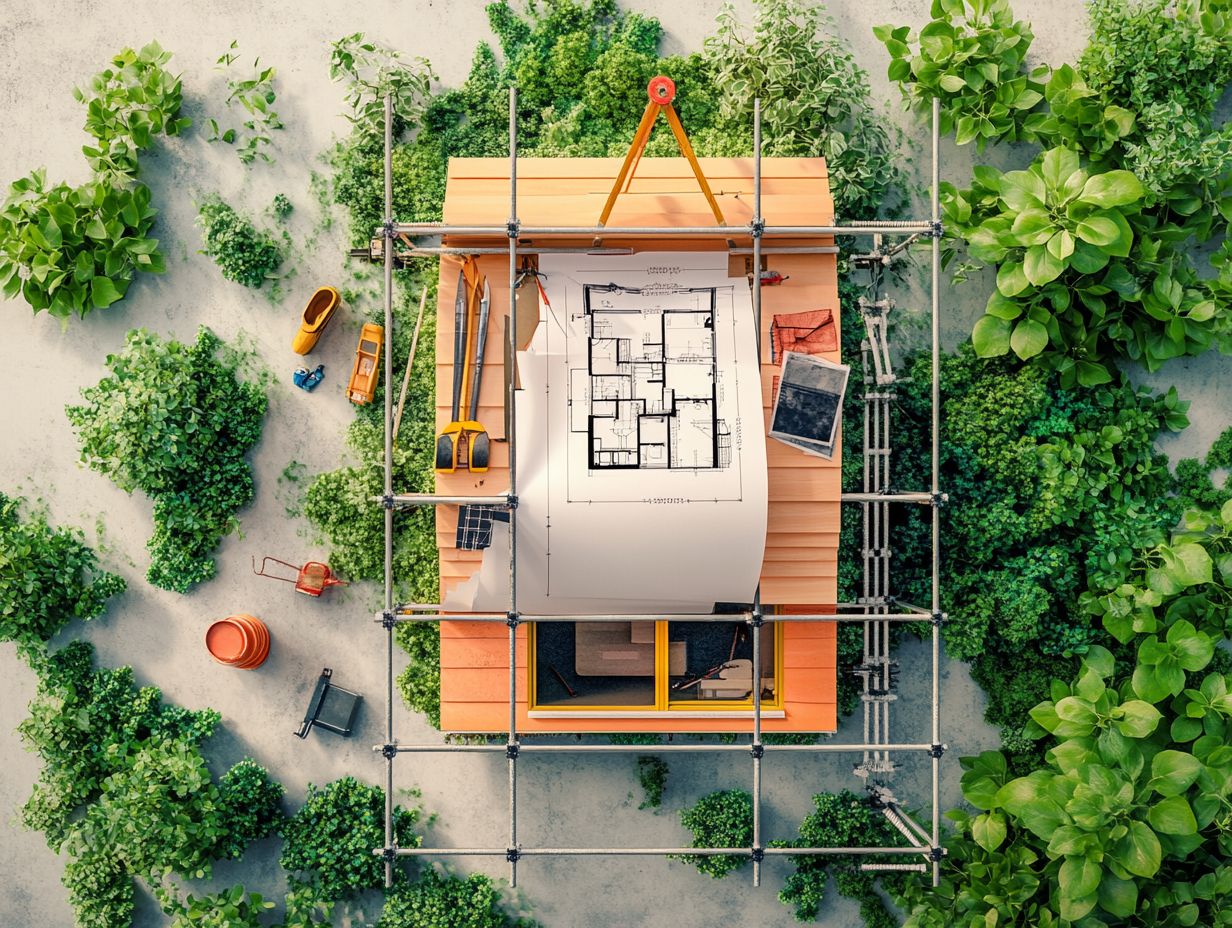
- Know the zoning and building codes in your area before renovating a tiny house to ensure compliance and avoid legal issues.
- Explore different financing options and consider getting insurance coverage before starting a tiny house renovation project.
- Choose sustainable and safe materials. Find reliable contractors to maximize space and functionality in your tiny house renovation.
What are Tiny Houses and Why Renovate?
In this guide, we’ll explore the tiny house community that supports tiny house enthusiasts.
Tiny houses embody a significant shift in contemporary living, championing sustainability, minimalism, and adaptability. These compact spaces, typically measuring between 100 and 400 square feet, are not just a fleeting trend; they represent a movement that encourages you to reevaluate your lifestyle choices and consider the benefits of tiny house models.
The tiny house movement emphasizes efficient use of space and resources. It fosters a vibrant community of tiny homeowners who embrace a simpler, more intentional way of life. Renovating a tiny house can elevate both its functionality and aesthetic charm, making it an enticing project for homeowners and enthusiasts alike.
Legal Considerations for Renovating a Tiny House
When you start tiny house renovations, understanding the legal landscape is essential. Many regulations can greatly impact your project.
As a tiny house enthusiast, you may encounter a complex web of building codes, including California Title 25 and Florida tiny house laws. Zoning regulations vary from state to state. You must consult your local planning commission right away to understand tiny house-friendly states and their regulations. Additionally, seeking tiny house legal assistance can be invaluable in navigating these challenges.
Doing so ensures that your renovations align with the International Building Code, a set of regulations that ensures safety in construction, International Residential Code, and local tiny house regulations. Additionally, being aware of the legal implications of tiny house ownership ultimately protects your investment and fosters community acceptance.
Zoning and Building Codes
Zoning and building codes are critical when it comes to the legality and feasibility of your tiny house renovations. They dictate exactly how and where your tiny home can exist. Knowing local zoning regulations is crucial. They decide if a tiny house on wheels or a foundation is allowed in your area, especially in tiny house-friendly states.
Specific building codes outline requirements such as minimum ceiling heights, safety standards, and construction guidelines that you must follow as a tiny house builder or owner.
Regulations can vary widely from state to state. For example, some regions embrace tiny houses with open arms and have tailored codes to encourage their growth, while others enforce strict restrictions that can complicate ownership. You may encounter challenges like land use permits, homeowner association approvals, or even limitations on size and cost influenced by tiny house legal resources.
States such as Oregon and Texas are renowned for being tiny house-friendly, offering greater flexibility in zoning. In contrast, places like New York City impose strict regulations that can stifle your creative renovation plans.
Navigating these complexities will greatly affect your renovation approach. It often requires meticulous planning and consultation with local authorities to ensure compliance and sidestep legal pitfalls.
Permits and Inspections
Obtaining the necessary permits and undergoing inspections is a crucial step in your tiny house renovation process, including consultations with the local building department to ensure you stay compliant with local regulations. As a tiny house builder or owner, you must engage with your building department to secure the required permits, which can include approvals for structural, electrical, and plumbing work, depending on the scope of your renovations, particularly under tiny house regulations.
These processes are vital for maintaining safety standards and can differ significantly based on your local planning commission’s requirements, especially in tiny house rentals friendly states.
Without these permits, you face the risk of costly fines and potential safety hazards that might arise from unregulated renovations. Engaging with the building department not only streamlines your renovation process but also helps establish a structured timeline that can significantly impact how quickly your project comes together, particularly when navigating the impact of local laws on tiny house living.
Inspections are an essential part of this journey, ensuring that all work complies with building codes and standards, thereby safeguarding the integrity of your structure. Being well-versed in these regulations, including the permits needed for tiny house construction that apply specifically to tiny homes, can truly make the difference between a successful renovation and a drawn-out, complicated ordeal.
Financing and Insurance for Tiny House Renovations
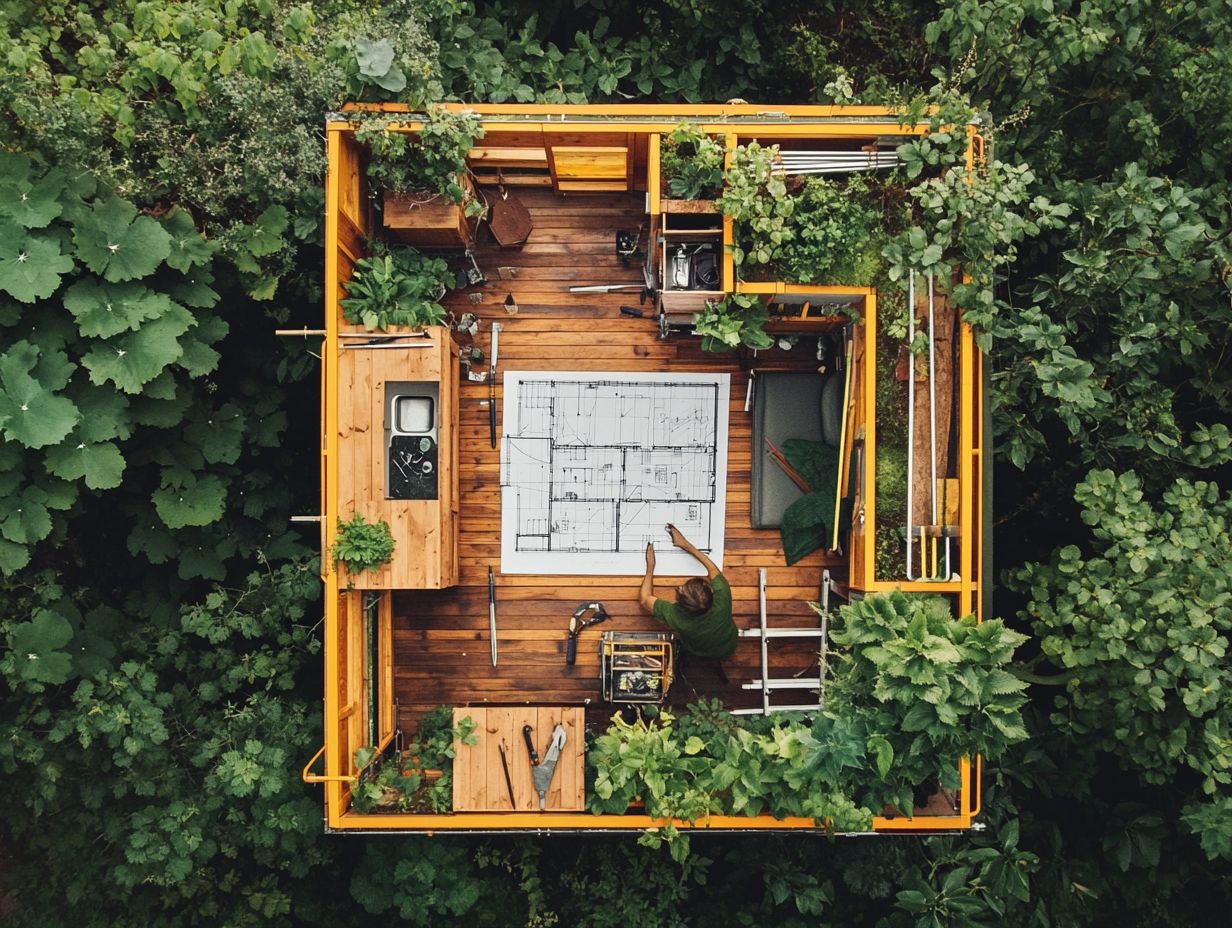
Understanding the money options for tiny house renovations requires a keen understanding of various financing options, including specialized tiny house loans, and insurance coverage, essential for both tiny house builders and owners.
Given the distinctive nature of tiny homes, including tiny houses on wheels, traditional mortgages often don t fit the bill, leading many homeowners to explore alternative financing methods like personal loans or specialized tiny house loans.
It’s also important to secure the right insurance coverage to safeguard your investment and ensure compliance with the myriad of tiny home laws, including those under the California Title 25 and Florida tiny house laws, as well as other regulations that come into play during renovations.
Options for Financing
You have several financing options at your disposal for tiny house renovations, each one designed to cater to your unique needs as a tiny house owner or builder.
Personal loans are great because they re easy to get, typically requiring nothing more than a credit check and proof of income for approval. Alternatively, specialized tiny house loans are often provided by lenders who truly understand the distinctive nature of tiny homes. These loans can come with more favorable terms compared to traditional mortgage options.
If you’re considering grant opportunities, it’s crucial to research local programs that might support sustainable housing initiatives and the broader goals of the Tiny House Movement. Every financing option has its own rules and benefits; for example, while personal loans might involve higher interest rates, they offer swift access to cash.
As the tiny house market continues to flourish, lenders are evolving too, expanding their offerings to facilitate financing for both renovations and new builds. This gives more individuals the power to embrace the minimalist lifestyle.
Don’t miss out! Explore your financing options today to start your dream tiny home!
Insurance Coverage for Renovations
Insurance coverage for tiny home renovations is essential to protect yourself from unexpected expenses and construction risks. You should aim for complete insurance, which protects against various risks, including liability, property damage, and personal injury.
By securing the right insurance, you can enjoy peace of mind throughout your renovation journey. Keep in mind that many states have unique regulations governing tiny homes that could influence your insurance needs, such as zoning laws or building codes requiring specialized coverage.
Liability insurance is particularly critical, as it shields you from potential accidents on your property. In contrast, property insurance offers financial safety in case of damage to structures or materials.
Considering the ever-evolving tiny house market, consulting with insurance experts specializing in this niche is a wise move. They can help you navigate the complexities of coverage options and ensure compliance with local laws, including tiny house laws, ultimately safeguarding your investment during the renovation process.
Choosing Materials and Contractors
Choosing the right materials and contractors is crucial for your tiny home renovations. This choice influences both the quality and sustainability of your project. Make sure to choose sustainable materials that minimize environmental impact and maximize functionality in cozy spaces.
Working with trustworthy contractors who understand the unique challenges of tiny house construction significantly enhances your renovation experience. It ensures your project aligns beautifully with the values of the tiny house community and helps you navigate the legal risks of building a tiny house.
Sustainable and Safe Materials
Selecting sustainable and safe materials is vital for your tiny house renovations. This choice upholds both environmental responsibility and occupant safety. As a tiny house builder, you might consider reclaimed wood, eco-friendly insulation, and non-toxic finishes, which resonate with the core values of the tiny house movement.
These smart choices can help reduce your carbon footprint while improving indoor air quality. This creates a healthier living space for you. For example, bamboo flooring is a fantastic alternative to traditional hardwood; its rapid renewability and lower emissions make it appealing.
Opting for low-VOC paints and finishes can significantly reduce harmful pollutants, benefiting both you and the surrounding ecosystem. As the tiny house community evolves, you’ll notice a growing trend toward sourcing materials locally.
This not only supports regional economies but also dramatically lowers transportation emissions, reinforcing your commitment to sustainability and efficiency.
Finding Reliable Contractors
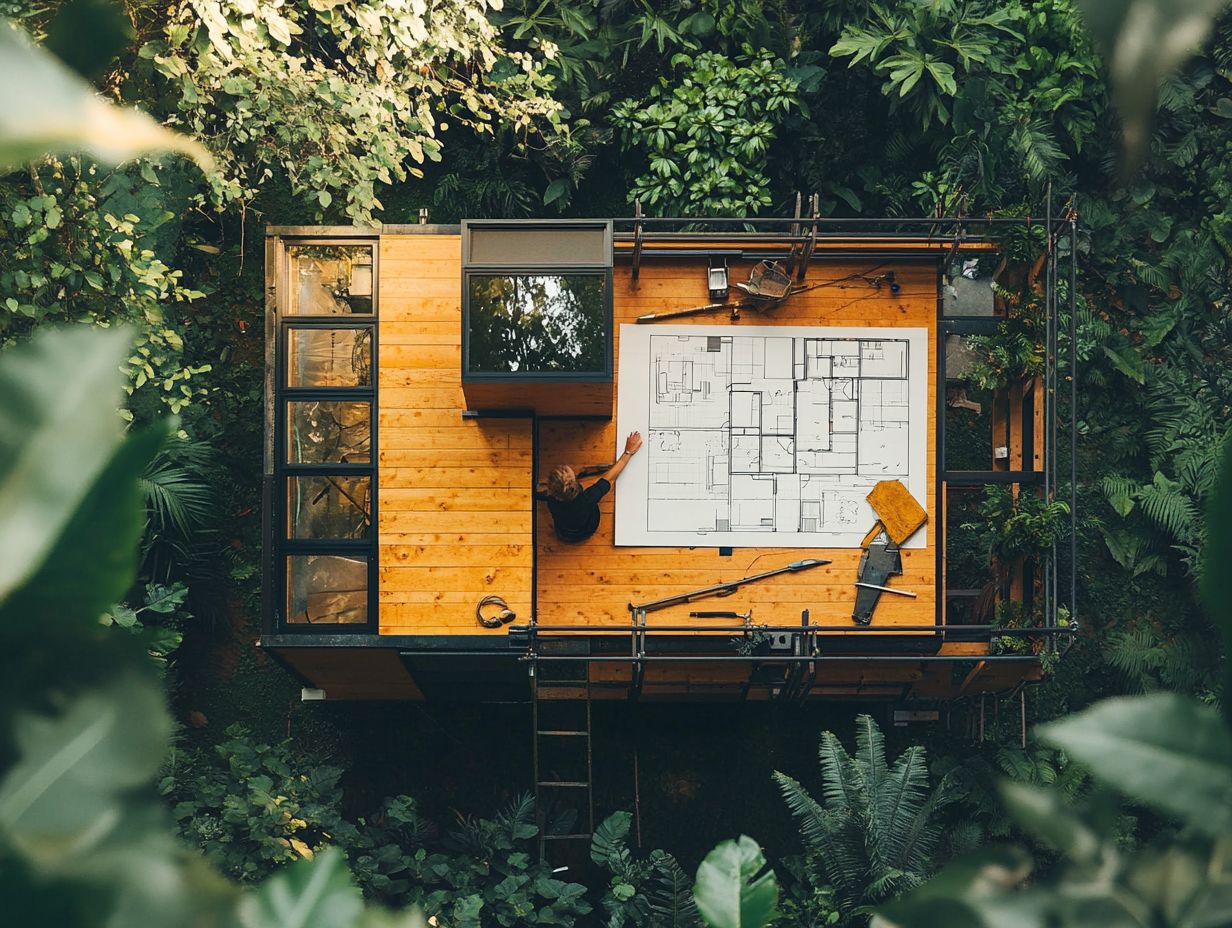
Finding reliable contractors for your tiny house renovations is essential to ensure top-notch workmanship and compliance with building codes. By connecting with specialists familiar with the tiny house community, you gain valuable insights and resources that enhance your renovation experience.
Networking through local tiny house groups, forums, or online platforms can lead you to contractors who truly understand the unique needs and challenges of tiny home construction.
As a potential client, thoroughly vet these professionals. Ask for references and review their previous work portfolios. Viewing past projects reveals the contractor s style and attention to detail while showcasing their experience with similar renovations.
Determining how well-versed they are in tiny house regulations is equally important. This knowledge can save you time and prevent costly missteps. Community recommendations can prove invaluable, and exploring online resources, like reviews or testimonials, can further bolster your confidence in selecting trustworthy contractors for your specialized project. Additionally, it’s crucial to understand tiny house zoning laws to ensure compliance with local regulations.
Maximizing Space and Functionality
Maximizing space and functionality is a primary objective for your tiny house renovation. Every square foot is precious in these compact homes.
With innovative design tips, you can elevate the usability of your tiny house. Create multi-functional areas that cater to your needs while maintaining comfort.
By using clever storage solutions and strategic layout designs, you can transform even the coziest of spaces into efficient and inviting living environments.
Design Tips for Tiny House Renovations
Using smart design ideas can truly enhance both aesthetics and functionality in your cozy tiny house. Make the most of your area by incorporating vertical storage, open shelving, and convertible furniture, all while maintaining a visually appealing environment.
Thoughtful design choices enhance usability and embody the core values of the tiny house movement, emphasizing simplicity and efficiency.
Consider incorporating multifunctional pieces like a foldable dining table or a sofa that transforms into a bed. This way, you can adapt your living space for various activities without sacrificing comfort.
Utilizing large windows creates the illusion of more space and floods your interiors with natural light, significantly boosting the ambiance and overall mood.
The tiny house community is filled with inspiring examples of innovative layouts, such as built-in storage solutions cleverly hidden under staircases or lofted sleeping areas. These strategic decisions empower you to enjoy a more organized and serene living experience, making every square inch count.
Storage Solutions and Space-Saving Ideas
Innovative storage solutions and space-saving ideas are essential for your tiny house renovations. These strategies enable you to make the most of every precious inch.
Incorporate under-bed storage, wall-mounted shelves, and cleverly hidden compartments to enhance functionality while keeping your living areas organized and clutter-free.
Get creative with the space you have! These clever strategies elevate the aesthetic appeal of your compact home while embodying the philosophy of simplicity and resourcefulness at the heart of the tiny house movement.
Multifunctional furniture, like foldable dining tables and convertible sofas, serves multiple purposes while conserving those precious square feet.
Optimizing vertical space with tall cabinets or floating shelves can significantly enhance organization. Embracing these techniques allows you to cultivate a serene living environment, fully immersing yourself in your journey toward intentional and sustainable living.
Frequently Asked Questions
What are the legal considerations for tiny house renovations?

Legal considerations for tiny house renovations include obtaining proper permits and adhering to building codes, zoning regulations, and safety standards.
Do I need a permit to renovate my tiny house?
It depends on the extent of your renovations and local building codes. Always check with your local government to determine if a permit is necessary.
Are there any zoning restrictions for tiny house renovations?
Yes, zoning restrictions may limit the size, location, and use of tiny houses. Research these restrictions before starting renovations to avoid legal issues.
What safety standards should I consider for my tiny house renovations?
Consider safety standards like proper insulation, electrical wiring, and plumbing to ensure the safety and comfort of anyone living in the tiny house.
Ready to take your tiny house to the next level? Let s dive in!
Can I legally rent out my renovated tiny house?
The legality of renting out a tiny house depends on your location. Some areas may require a permit or have restrictions on short-term rentals.
It’s crucial to research your local laws to ensure compliance.
What legal documents should I have for my tiny house renovations?
To protect yourself legally, obtain necessary building permits and contracts with any contractors or subcontractors.
Also, make sure to have proof of insurance for your renovations.

